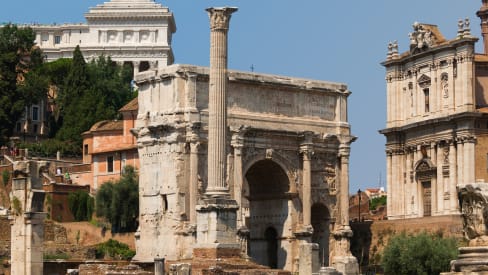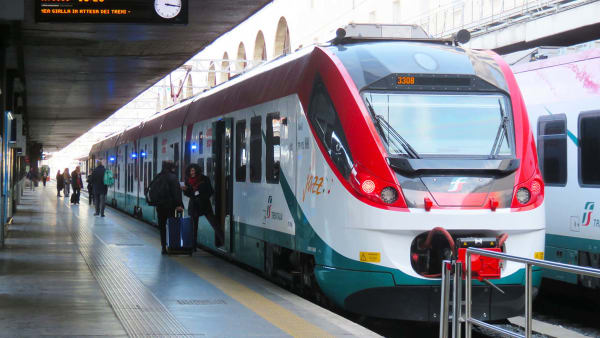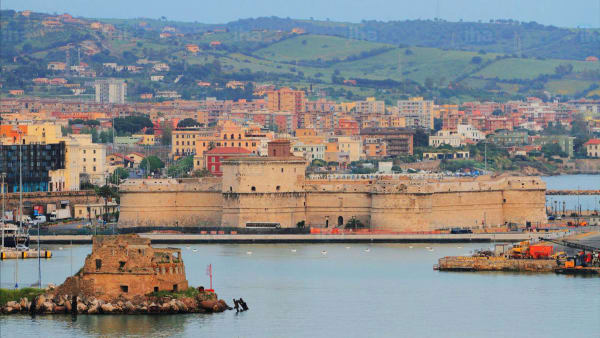Nearby places of interest
Nearby places of interest
As mentioned before, the Roman Forum is surrounded by other attractions. Here’s a list of sights you can visit within walking distance from the Forum.
Colosseum
The Flavian Amphitheater is the most important symbol of Italy and therefore definitely worth a visit during your stay in Rome. Each year, about six million travelers visit the ruins of the Colosseum, which are among the new seven world wonders.
Admission to the Roman Forum, the Colosseum, and the Palatine is included in a single ticket .
The Colosseum is located on the east side of the Roman Forum (5-minute walk).
Palatine Hill
The Palatine is one of the seven hills of Rome and the first that was inhabited. Since the imperial period, it was the hill where the emperors built their palaces.
Here you can visit, among others, the remains of the residences of the House of Augustus, the Domus Tiberiana, the House of Livia, the Domus Aurea, the Farnesian Gardens, the Domus Transitoria, and the Hut of Romulus.
The Palatine is accessible from the Roman Forum. From the outside, there is an entrance 500 m south of the Colosseum (a 7-minute walk).
Arch of Constantine
Among the three Arches of Triumph that still exist in Rome, this is the best-preserved one. The striking monument was built in the early fourth century to commemorate the victory of Constantine I at the Battle of Milvian Bridge in 312 AD.
It’s the last great monument of Imperial Rome and was inaugurated on the 10th anniversary of Constantine’s reign. It’s an imposing 21 meters high and 25.6 m wide and stood on Rome’s triumphal route.
The Arch of Constantine is located near the exit of the Forum (the one along Via Sacra, next to the Colosseum).
Imperial Fora
The Fori Imperiali consists of a series of monumental fora (public squares). They were built over a total period of 150 years, between 46 BC and 113 AD. Over the years, Caesar, Vespasian, Augustus, Nerva, and Trajan contributed to its development.
The Imperial Fora were built to replace the Roman Forum after it became too small due to strong population growth and could no longer fulfill its purpose as the center of Rome.
The entrance to the Imperial Fora is in the northern part of the Roman Forum, across Via dei Fori Imperiali (a 5-minute walk).
Piazza Venezia
Piazza Venezia with the Altare della Patria is among the iconic sights of Rome. It’s located at the foot of Campidoglio hill, where five of the city’s main streets intersect. It’s named after the nearby Palazzo Venezia, which was used as the embassy of the Venetian Republic in Rome.
A few sights in this square include Palazzo Bonaparte, the Monument to Victor Emanuel II, Palazzo Venezia, Basilica San Marco, and the bust of Madame Lucrezia.
Piazza Venezia is located west of the Roman Forum, on the other side of Via dei Fori Imperiali (a 5-minute walk).
Circus Maximus
Considered to be the largest sports stadium built by man, this archaeological area was the site of legendary entertainment activities for nearly a thousand years.
Most of the building is underground and there’s not much left to see above ground. However, through a virtual reality tour , you can discover what the circus used to look like. It’s definitely worth a visit.
The entrance to the Circus Maximus is 900 m south of the Roman Forum (an 11-minute walk).
Domus Aurea
The remains of the great palace that Emperor Nero ordered to be built in 64 AD can be visited in a virtual reality experience tour .
The virtual reality glasses allow you to explore Nero’s extravagant residence in all its glory and get an idea of what it would have looked like at the time.
The entrance to the Domus Aurea is 550 m northeast of the Forum Romanum (a 6-minute walk).
Ludus Magnus
The Ludus Magnus was the largest of the four ludi (gladiatorial schools) known from ancient Rome. The rectangular building complex was commissioned by Emperor Domitian (81-96) and completed by Hadrian (117-138).
The building was located in the valley between the Caelius and the Esquiline, east of the Colosseum—to which it was connected by a subterranean passage.
The Ludus Magnus can be reached by crossing the street from the east side of the Forum Romanum (a 7-minute walk).
Basilica of San Clemente
This intriguing building is a Roman Catholic church dedicated to Pope Clement I. The first tier was built in the fourth century, making it one of the oldest Christian churches in Rome.
Over the centuries, three successive floors have been built over it, of which the top three can be visited. During a visit, you can admire (among other things) the underground temple of the Persian sun-god Mithras and numerous medieval frescoes.
The Basilica of San Clemente is 650 m from the Roman Forum (an 8-minute walk).















